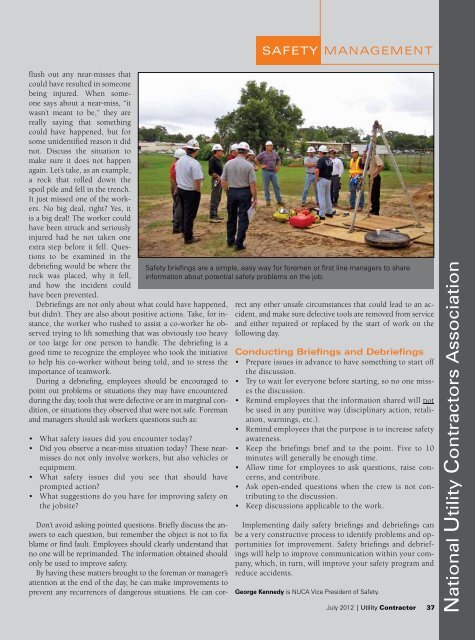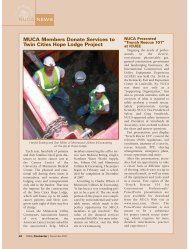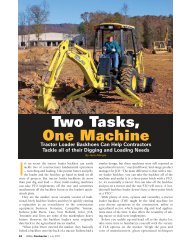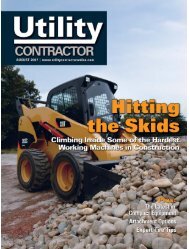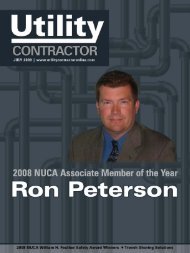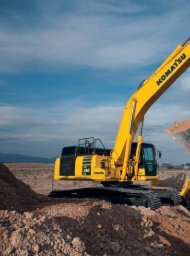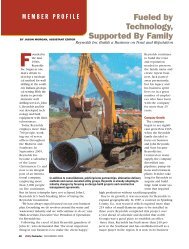View Full July PDF Issue - Utility Contractor Magazine
View Full July PDF Issue - Utility Contractor Magazine
View Full July PDF Issue - Utility Contractor Magazine
You also want an ePaper? Increase the reach of your titles
YUMPU automatically turns print PDFs into web optimized ePapers that Google loves.
flush out any near-misses thatcould have resulted in someonebeing injured. When someonesays about a near-miss, “itwasn’t meant to be,” they arereally saying that somethingcould have happened, but forsome unidentified reason it didnot. Discuss the situation tomake sure it does not happenagain. Let’s take, as an example,a rock that rolled down thespoil pile and fell in the trench.It just missed one of the workers.No big deal, right? Yes, itis a big deal! The worker couldhave been struck and seriouslyinjured had he not taken oneextra step before it fell. Questionsto be examined in thedebriefing would be where therock was placed, why it fell,and how the incident couldhave been prevented.Debriefings are not only about what could have happened,but didn’t. They are also about positive actions. Take, for instance,the worker who rushed to assist a co-worker he observedtrying to lift something that was obviously too heavyor too large for one person to handle. The debriefing is agood time to recognize the employee who took the initiativeto help his co-worker without being told, and to stress theimportance of teamwork.During a debriefing, employees should be encouraged topoint out problems or situations they may have encounteredduring the day, tools that were defective or are in marginal condition,or situations they observed that were not safe. Foremanand managers should ask workers questions such as:• What safety issues did you encounter today?• Did you observe a near-miss situation today? These nearmissesdo not only involve workers, but also vehicles orequipment.• What safety issues did you see that should haveprompted action?• What suggestions do you have for improving safety onthe jobsite?safety managementSafety briefings are a simple, easy way for foremen or first line managers to shareinformation about potential safety problems on the job.Don’t avoid asking pointed questions. Briefly discuss the answersto each question, but remember the object is not to fixblame or find fault. Employees should clearly understand thatno one will be reprimanded. The information obtained shouldonly be used to improve safety.By having these matters brought to the foreman or manager’sattention at the end of the day, he can make improvements toprevent any recurrences of dangerous situations. He can correctany other unsafe circumstances that could lead to an accident,and make sure defective tools are removed from serviceand either repaired or replaced by the start of work on thefollowing day.Conducting Briefings and Debriefings• Prepare issues in advance to have something to start offthe discussion.• Try to wait for everyone before starting, so no one missesthe discussion.• Remind employees that the information shared will notbe used in any punitive way (disciplinary action, retaliation,warnings, etc.).• Remind employees that the purpose is to increase safetyawareness.• Keep the briefings brief and to the point. Five to 10minutes will generally be enough time.• Allow time for employees to ask questions, raise concerns,and contribute.• Ask open-ended questions when the crew is not contributingto the discussion.• Keep discussions applicable to the work.Implementing daily safety briefings and debriefings canbe a very constructive process to identify problems and opportunitiesfor improvement. Safety briefings and debriefingswill help to improve communication within your company,which, in turn, will improve your safety program andreduce accidents.George Kennedy is NUCA Vice President of Safety.<strong>July</strong> 2012 | <strong>Utility</strong> <strong>Contractor</strong> 37National <strong>Utility</strong> <strong>Contractor</strong>s Association


